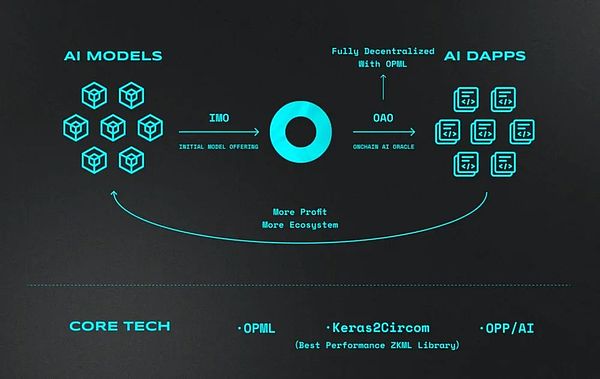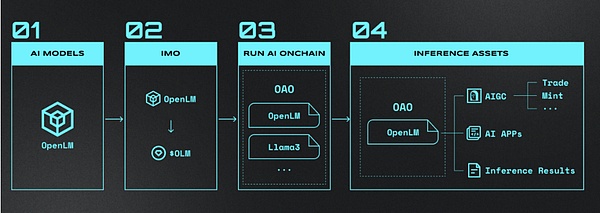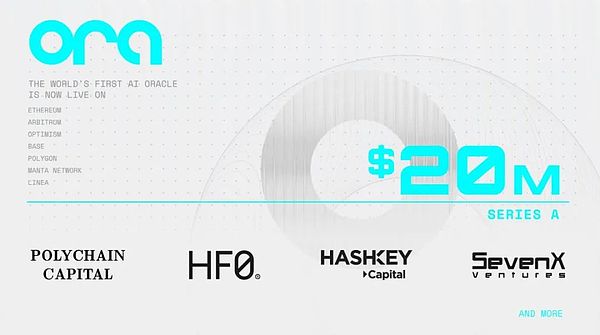Source: FutureMoney
What the crypto market lacks is never opportunities, but vision.
What does ORA do as a recently popular AI model tokenization platform? Why do major well-known institutions favor it?
How ORA works
ORA is a verifiable oracle protocol that brings AI and complex computing to the Ethereum blockchain. Its main product is the on-chain AI oracle, which currently supports LlaMA 2 (7B) and Stable Diffusion models, and will support more machine learning models in the future. ORA breaks through the limitations of smart contracts by providing AI reasoning, allowing developers to innovate freely. ORA's two main products are on-chain AI Oracle (OAO) and initial model provision (IMO).

On-chain OAO brings verifiable AI reasoning to the blockchain, providing trustless and permissionless use of AI. This opens the door to a variety of new application scenarios that were previously unattainable. Fees are charged for using the on-chain AI Oracle, which are then distributed to IMO token holders.
The Initial Model Offering (IMO) incentivizes long-term and sustainable open source contributions by tokenizing the ownership of open source AI models. It not only funds AI development, but also rewards the community and open source contributors. Token holders will receive a portion of the revenue generated by the use of the model on-chain.
Together, IMO and OAO have pushed the forefront of open source development.
OAO Features and Advantages
First of all, OAO is very developer-friendly. Developers can use the on-chain AI Oracle (OAO) to enhance the AI capabilities of smart contracts.
OAO’s key features include:
Integrated infrastructure with integrated AI capabilities and automation
Higher performance and shorter final confirmation time
Run arbitrary programs and large machine learning models
Secondly, the ORA Oracle Network consists of node operators running AI Oracle nodes, providing the following advantages:
Unstoppable autonomous protocols and networks
Best crypto-native decentralization
Verifiable, decentralized and secure network
Security of the base layer
Efficient allocation of computing power
1-of-N trust model
IMO Features and Advantages
IMO’s goal is to promote the development of AI in a sustainable, diverse and open direction for everyone.
IMO provides sustainable funding for open source AI models by tokenizing AI models on the blockchain, while promoting the distribution and continued contribution of models by adjusting the value and incentive mechanism of the ecosystem. At the same time, IMO allows anyone and the community to tokenize their AI models. This initiative enables the community to effectively raise funds for open source projects while incentivizing contributors to continuously improve globally accessible AI models.


ORA-initiated vision: Towards the world's supercomputer
ORA is committed to supporting Ethereum as the world's computer and its ecosystem to advance the future development of DeFi, zkML, AI and cryptocurrency.
A comprehensive and innovative base model
ORA built an on-chain AI oracle through opML (Optimistic Machine Learning), which enables on-chain machine learning reasoning for any model. In addition, ORA also built Keras2Circom (the world's first zkML framework) and invented opp/ai (the final framework for on-chain AI, integrating zkML and opML).
A base model for all kinds of developers
Developers can use ORA on-chain oracle to build any AI DApp driven by machine learning and with Ethereum as a security layer. Specifically, developers can build ai/fi (AI + DeFi) applications based on AI models, and AIGC NFT (ERC-7007 protocol) based on text-to-image models.

Some example use cases of ORA include creating AIGC NFTs with ERC-7007, facial recognition with zkKYC based on machine learning, on-chain AI games such as Dungeons & Dragons, prediction markets using machine learning, content authenticity verification (deep fake verifier), compliant programmable privacy, tip markets, and reputation/credit scoring. For more integration examples and building ideas, check out awesome-ora.

ai/fi = AI + DeFi
ai/fi is the combination of AI and DeFi, driving new developments in DeFi through ORA's Onchain AI Oracle, which provides verifiable AI inference. This concept redefines the fields of AMM, lending protocols, aggregators, stablecoins, etc., by identifying the computationally intensive parts of DeFi protocols and applying AI to achieve transformation. ORA also provides zkOracle, which allows trustless access to AI data sources for any ai/fi project.
Financing and Team
ORA recently announced that it has received a total of US$20 million in funding from investors such as Polychain Capital, HF0, Hashkey Capital, and SevenX. The funds will help ORA continue to develop its technology and infrastructure, tokenize AI models, and introduce decentralized AI to the Ethereum ecosystem, including Arbitrum, Optimism, Base, Linea, and other EVM-compatible chains.
At the same time, ORA also has a relatively good professional team background. Kartin Jiatian Wong has worked in Web2 giants such as Google and Tiktok, and has work experience in Web3.0, cloud computing, and quantum computing applications; Cathie So is a scientist at the Ethereum Foundation and has created Erc-7641 and Erc-7007 protocols for IMO.

In the future, all AI models can be sold on the chain through ORA, and 189 billion yuan of investment will flow into AI companies in 2023. We can imagine that ORA will be a sustainable market business worth hundreds of billions of yuan, adding more tension and space to Crypto AI.
 JinseFinance
JinseFinance
 JinseFinance
JinseFinance JinseFinance
JinseFinance JinseFinance
JinseFinance JinseFinance
JinseFinance Brian
Brian Others
Others Coindesk
Coindesk Coindesk
Coindesk Cointelegraph
Cointelegraph Cointelegraph
Cointelegraph